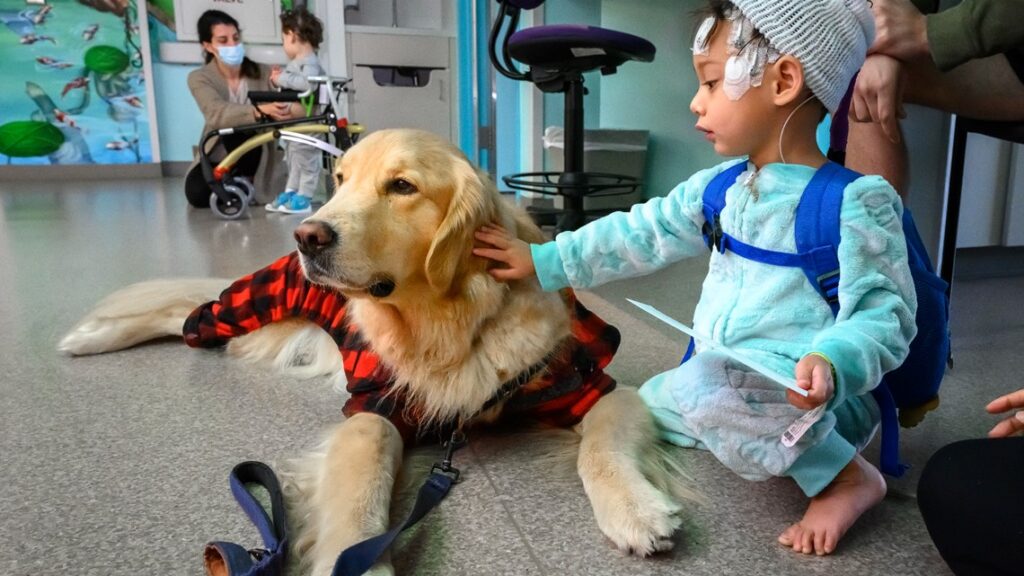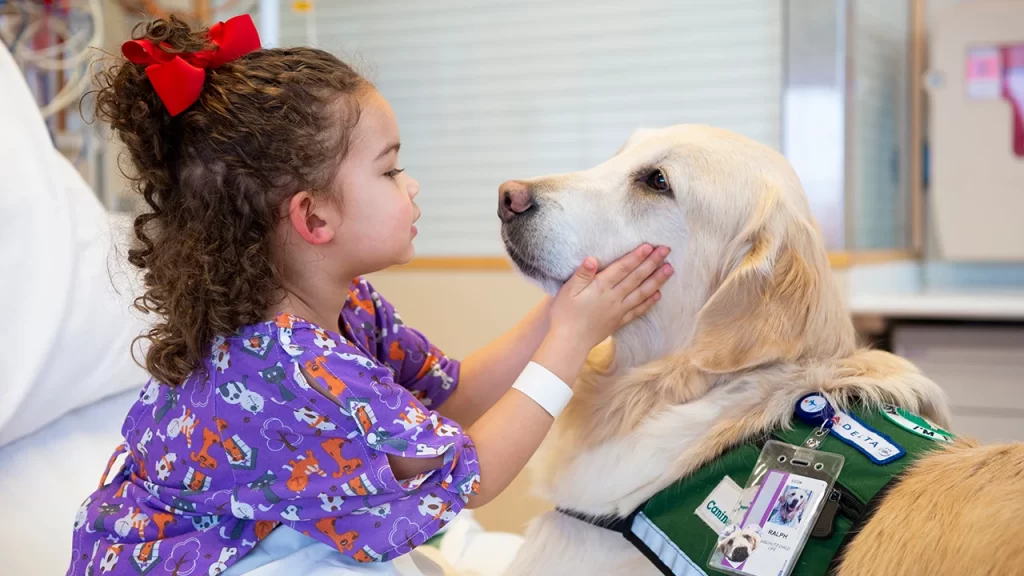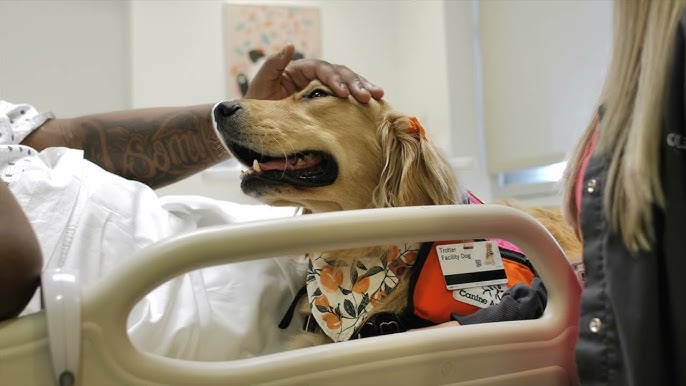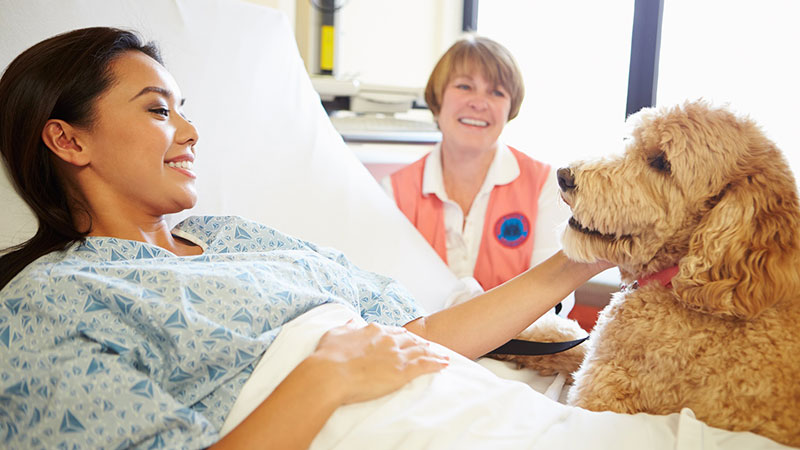Your furry companion is an angel in a fur coat, and every encounter with your dog brings smiles to those around. You’ve probably heard about the incredible benefits that dogs bring to elderly patients in hospitals. This is where the concept of “dog training for hospital visits” comes into play. Their ability to lower blood pressure, speed up recovery times, and simply bring joy to people’s lives is well-documented. In this blog post, we’ll explore the invaluable role trained therapy dogs play in healthcare settings, how they provide emotional support, and the steps to prepare your dog for this remarkable journey.
Defining the Requirements
Becoming a hospital therapy dog is no small feat. Such dogs are expected to be paragons of canine behavior. They must not only exhibit impeccable behavior at all times but also remain unflappable in the face of the unexpected. Moreover, they must graciously accept the attention of strangers without experiencing anxiety or distress.
This level of excellence necessitates a dog with a strong foundation in socialization from a young age and a high degree of basic obedience training. Meeting the Kennel Club’s “good canine citizen” standards is often the baseline requirement. This means that the dog should be well-mannered, composed in various situations, and unfailingly obedient to their owner.
Additionally, the dog must be in excellent health, up-to-date on vaccinations, and maintained in a clean and healthy condition.

By the way – if you’re looking for a comprehensive dog training program to dive into the fundamentals of dog training, I highly recommend Adrienne Farricelli’s “Brain Training For Dogs” program.
It’s a great program that really offers a deep dive so that you’ll be able to understand the why, as well as the how, of dog training.
The Healing Power of Dogs in Hospitals
The mere presence of a friendly dog can alleviate anxiety and provide emotional support for patients undergoing medical procedures or facing health challenges.
Interacting with dogs has been shown to lower stress levels, reduce heart rate, and promote relaxation, which can aid in the healing process.
For young patients, especially children, dogs serve as delightful distractions from medical concerns and provide comfort in an unfamiliar setting.
The joy that dogs bring can uplift the spirits of patients, families, and even hospital staff, creating a more positive atmosphere.

The Role of a Trained Therapy Dog
A trained therapy dog can offer a calming presence and create positive experiences in a hospital environment. Here are some ways in which therapy dogs assist in healthcare settings:
Social Interaction: Therapy dogs encourage social interaction among patients, helping to reduce feelings of isolation.
Companionship: They offer companionship and comfort to patients, especially those who may not have regular visitors.
Motivation: Therapy dogs can motivate patients to engage in physical therapy or other activities that aid their recovery.
Stress Reduction: The unconditional love and acceptance from a therapy dog can significantly reduce stress and anxiety.
Preparing Your Dog for Hospital Visits
Considering the demand for unwavering composure in a range of situations, most hospital therapy dogs are adult dogs in their middle or mature years. They’ve outgrown the spirited antics of puppyhood and have matured into well-behaved companions. To train a dog to meet the high standards of hospital therapy work, you’ll need the following:
If you’re considering training your dog to be a therapy dog for hospital visits, here are some steps to get started:
Assess Suitability: Not all dogs are suitable for the role. Your dog should be well-behaved, friendly, and comfortable around strangers. They should also be obedient and respond to basic commands.

Handling Sudden Noises
Certain noises, like a stainless steel kidney dish crashing to the floor, can be startling for most dogs. To acclimate your dog, practice at home by having a friend make different noises from a distance. Reward your dog when they remain calm and don’t react to the sounds. Slowly bring the noise source closer, continuing to reward your dog for their calm behavior.
Meeting New People
In a hospital setting, your dog will encounter many new faces and must greet them in a calm and accepting manner. Socialization should start during your dog’s puppyhood, with gentle exposure to various people who reward your dog’s calmness with treats. As your dog matures, ensure they regularly meet people and enjoy their company, rewarding them with praise, attention, or treats.
Accepting Human Noises
A variety of human-generated sounds, from coughing to shouting, fill hospital environments. Prepare your dog for this by exposing them to such noises at home. Begin with quieter versions of these sounds and gradually increase the volume, always rewarding your dog’s composure.
Familiarity with Medical Equipment
Your dog should be comfortable around medical equipment, including wheelchairs and other mobility aids. Gradually introduce your dog to these items by walking them past a wheelchair at a distance and slowly moving closer to acclimate them.
Desensitization: Gradually expose your dog to hospital-like environments, including medical equipment and busy corridors. This will help them acclimate to the surroundings.
Temperament Testing: Consider having your dog undergo temperament testing to assess their suitability for therapy work. Some organizations may require this.
Certification: Many hospitals and therapy dog organizations require certification.

Dog Training for Hospital Visits: The Process
The training process for hospital visits requires dedication and consistency. Here are some essential aspects to consider:
Behavior Training: Your dog should be well-behaved and obedient. They must respond promptly to commands and be able to stay calm in various situations.
Socialization: Expose your dog to different people, places, and situations to ensure they remain friendly and confident in diverse environments.
Health and Hygiene: Maintain your dog’s health and hygiene, including regular vet check-ups, vaccinations, and grooming.
Therapy Specific Training: Make sure your dog is trained to handle the unique situations they will encounter in a hospital. The presence of medical equipment and the need to remain calm during emotional moments are key to being a therapy dog.
Consistency: Consistent training and exposure to hospital settings will help your dog build the confidence required for this role.

Hospital Visits: What to Expect
When you and your therapy dog are ready for hospital visits, there are some important considerations:
Scheduled Visits: Most hospitals have scheduled visit times for therapy dogs. Ensure you adhere to these schedules and arrive on time.
Respect Privacy: Always respect the privacy of patients and their families. Ask for permission before approaching anyone.
Feedback: Be open to feedback from hospital staff and patients. This can help you and your dog continually improve your performance.
Boundaries: Be aware of your dog’s limits. If they seem stressed or tired, it’s important to recognize when it’s time to end the visit.
Dog training for hospital visits is a remarkable way to harness the healing power of our furry friends. These trained therapy dogs bring comfort, support, and smiles to those in need within healthcare settings. If you have a dog with the right temperament and are willing to put in the training effort, you can be part of this incredible journey to provide solace and companionship to patients, making a real difference in their lives. It’s a testament to the deep bond between humans and their canine companions.
Read more blog posts here.

